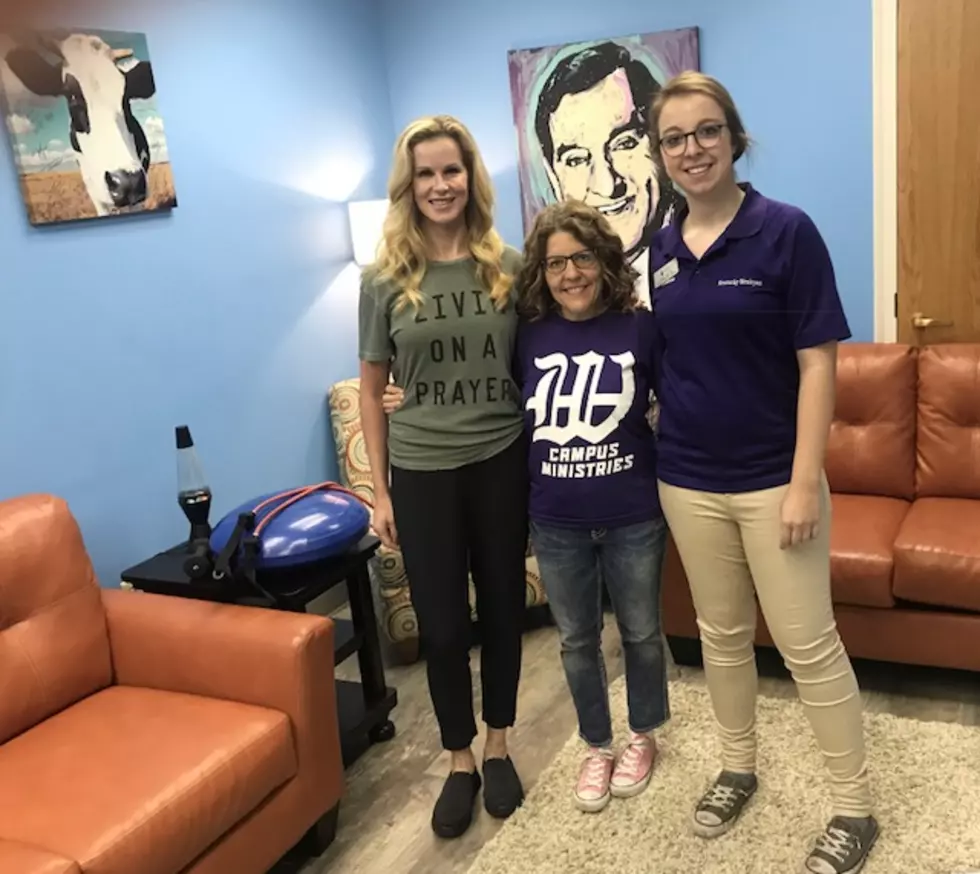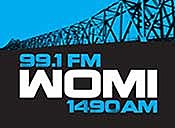![Theresa Rowe and Martha HaHus Discuss Breast Cancer Awareness Month [Podcast]](http://townsquare.media/site/77/files/2013/10/Martha-Hahus.jpeg?w=980&q=75)
Theresa Rowe and Martha HaHus Discuss Breast Cancer Awareness Month [Podcast]
Theresa Rowe is here with another podcast of her WOMI program, Shaped by Faith.
October is National Breast Cancer Awareness Month and so this entire show is dedicated to Breast Cancer Survivors and family and friends of those affected by Breast Cancer. Theresa spent all three segments of her show speaking with Martha HaHus, pictured below, who discusses her cancer experience.
SHAPED BY FAITH, OCTOBER 18, PART ONE WITH CANCER SURVIVOR MARTHA HAHUS
SEGMENT TWO, WITH CANCER SURVIVOR MARTHA HAHUS
SHAPED BY FAITH, OCTOBER 18, PART THREE WITH CANCER SURVIVOR MARTHA HAHUS
AN\nd, now here is the transcript from Teresa's show so that you may read it at your leisure. Links to the definition of the various topics are shown.
WOMI Radio Shaped by Faith
Breast Cancer Awareness
October 18 & 20th, 2013
Shaped by Fitness: Should a person exercise during cancer treatment & after
Shaped by Life: Interview Martha Hahus
Shaped by God: How God strengthens us when we are weak
October is National Breast Cancer Awareness Month and so this entire show is dedicated to Breast Cancer Survivors and family and friends of those affected by Breast Cancer.
Breast cancer is a disease in which malignant (cancer) cells form in the tissues of the breast.
Breast Cancer is the most common cancer among American Women. It is the second leading cause of cancer death in women each year aside from skin cancer. 178,480 females detected with breast cancer each year, 40, 460 females will die from this disease.
This disease is about 100 times more common among women.
This disease is rare in males, but 2, 030 males will be detected each year. 450 males will die form this disease.
My guest today is Martha Hahus, an absolutely Beautiful lady who has agreed to share with all of us her experience with Breast Cancer.
Tests that examine the breasts are used to detect (find) and diagnose breast cancer.
A doctor should be seen if changes in the breast are noticed. The following tests and procedures may be used:
- Physical exam and history : An exam of the body to check general signs of health, including checking for signs of disease, such as lumps or anything else that seems unusual. A history of the patient’s health habits and past illnesses and treatments will also be taken.
- Clinical breast exam (CBE): An exam of the breast by a doctor or other health professional. The doctor will carefully feel the breasts and under the arms for lumps or anything else that seems unusual.
- Mammogram : An x-ray of the breast.
Enlarge Mammography. The breast is pressed between two plates. X-rays are used to take pictures of breast tissue.
- Ultrasound exam:
- MRI (magnetic resonance imaging):
- Blood chemistry studies :
- Biopsy : Excisional biopsy : The removal of an entire lump of tissue.
- Incisional biopsy : The removal of part of a lump or a sample of tissue.
- Core biopsy : The removal of tissue using a wide needle.
- Fine-needle aspiration (FNA) biopsy : The removal of tissue or fluid, using a thin needle.
Health history can affect the risk of developing breast cancer.
Anything that increases your chance of getting a disease is called a risk factor. Having a risk factor does not mean that you will get cancer; not having risk factors doesn't mean that you will not get cancer. Talk with your doctor if you think you may be at risk. Risk factors for breast cancer include the following:
- Menstruating at an early age.
- Older age at first birth or never having given birth.
- A personal history of invasive breast cancer, ductal carcinoma in situ (DCIS), lobular carcinoma in situ (LCIS), or benign (noncancer) breast disease.
- A family history (first-degree relative, such as mother, daughter, or sister) of breast cancer.
- Having inherited changes in the BRCA1 or BRCA2 genes.
- Treatment with radiation therapy to the breast/chest.
- Having breast tissue that is dense on a mammogram.
- Taking hormones such as estrogen and progesterone for symptoms of menopause.
- Having taken the hormone diethylstilbestrol (DES) during pregnancy or being the daughter of a woman who took DES while pregnant.
- Obesity.
- Not getting enough exercise.
- Drinking alcoholic beverages.
- Being white.
Breast cancer is sometimes caused by inherited gene mutations (changes).
The genes in cells carry the hereditary information that is received from a person’s parents. Hereditary breast cancer makes up about 5% to 10% of all breast cancer. Some mutated genes related to breast cancer are more common in certain ethnic groups.
There are tests that can detect (find) mutated genes. These genetic tests are sometimes done for members of families with a high risk of cancer.
Possible signs of breast cancer include a lump or change in the breast.
Breast cancer may cause any of the following signs and symptoms. Check with your doctor if you have any of the following problems:
- A lump or thickening in or near the breast or in the underarm area.
- A change in the size or shape of the breast.
- A dimple or puckering in the skin of the breast.
- A nipple turned inward into the breast.
- Fluid, other than breast milk, from the nipple, especially if it's bloody.
- Scaly, red, or swollen skin on the breast, nipple, or areola (the dark area of skin that is around the nipple).
- Dimples in the breast that look like the skin of an orange
- Other conditions that are not breast cancer may cause these same symptoms.
Tests that examine the breasts are used to detect (find) and diagnose breast cancer.
A doctor should be seen if changes in the breast are noticed. The following tests and procedures may be used:
- Physical exam and history : An exam of the body to check general signs of health, including checking for signs of disease, such as lumps or anything else that seems unusual. A history of the patient’s health habits and past illnesses and treatments will also be taken.
- Clinical breast exam (CBE): An exam of the breast by a doctor or other health professional. The doctor will carefully feel the breasts and under the arms for lumps or anything else that seems unusual.
- Mammogram : An x-ray of the breast.
EnlargeMammography. The breast is pressed between two plates. X-rays are used to take pictures of breast tissue.
- Ultrasound exam:
- MRI (magnetic resonance imaging):
- Blood chemistry studies :
- Biopsy : Excisional biopsy : The removal of an entire lump of tissue.
- Incisional biopsy : The removal of part of a lump or a sample of tissue.
- Core biopsy : The removal of tissue using a wide needle.
- Fine-needle aspiration (FNA) biopsy : The removal of tissue or fluid, using a thin needle.
If cancer is found, tests are done to study the cancer cells.
Decisions about the best treatment are based on the results of these tests. The tests give information about:
- how quickly the cancer may grow.
- how likely it is that the cancer will spread through the body.
- how well certain treatments might work.
- how likely the cancer is to recur (come back).
Certain factors affect prognosis (chance of recovery) and treatment options.
- The stage of the cancer (the size of the tumor and whether it is in the breast only or has spread to lymph nodes or other places in the body).
- The type of breast cancer.
- Estrogen receptor and progesterone receptor levels in the tumor tissue.
- Human epidermal growth factor type 2 receptor (HER2/neu) levels in the tumor tissue.
- Whether the tumor tissue is triple-negative (cells that do not have estrogen receptors, progesterone receptors, or high levels of HER2/neu).
- How fast the tumor is growing.
- How likely the tumor is to recur (come back).
- A woman’s age, general health, and menopausal status (whether a woman is still having menstrual periods).
- Whether the cancer has just been diagnosed or has recurred (come back).
Some of the treatment choices for Breast Cancer are : Radiation, Chemotherapy, hormonal therapy & surgery.
Lifestyle choices may affect breast cancer risk. These day to day choices involve factors such as poor diet, insufficient physical activity, alcohol and smoking.
Cancer treatments take an enormous toll on the body; between weight gain, muscle atrophy and premature bond loss, women are left weak and physically challenged even by normal day to day activities.
Breast Cancer leaves many women feeling disconnected from their bodies and wary of exercise. Pilates exercises offer a gentle method to venture back toward physically and emotional health.
For a Cancer survivor who is rebuilding her foundation of physical strength – flexibility, endurance & self esteem are priorities.
Pilates is a mind/body exercise technique that stretches and strengthens the body through a series of flowing movements. It is unique because many of the exercises are performed in a supine position (lying face up) or side lying positions which allow the body to be centered and the spine to be aligned, putting less stress on the neck and back.
Pain and loss of range of motion in the shoulder and the chest are common issues for survivors who are considering exercise after treatment. Because many Pilates exercises are performed in the supine position, the neck and the back are supported, making it easier to feel which muscles are working in the back and to ensure the spine is supported and aligned in neutral. Pilates helps in regaining balance and muscle mass.
I would love to help anyone out there today who is going through breast cancer by giving you my Pilates for the Soul DVD as my gift to you.
Please contact me by email at Theresa@shapedbyfaith.com or call me at 270-929-8251 and I will send you my FREE Pilates DVD or a healing CD.
Here are some scripture verses to meditate on:
Proverbs 3:5
Trust in the Lord with all your heart and lean not on your own understanding; in all your ways acknowledge him and he will make your paths straight.
Isaiah 40:31
But those who hope in the Lord will renew their strength. They will soar on wings like eagles; they will run and not grow weary, they will walk and not be faint.
Philippians 4:13
I can do all things through Christ who strengthens me.
More From WOMI-AM









